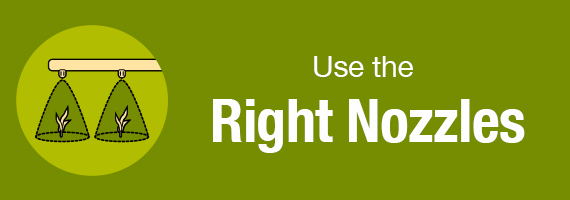Four Considerations for Choosing Corn Herbicides
Maximize return on herbicide investments by following the “4 Rs” of herbicide application.

Applying fertilizer to corn is a sound investment because adding nutrients to the soil helps reap higher yields. Many growers follow the “4 Rs” of nutrient management to make sure they’re getting the most out of their fertilizer. Consider herbicides a similar investment.
Similar to fertilizers, agronomists recommend following the “4 Rs” of herbicide applications to get the most out of your investment:
- Apply the right residual herbicide …
- At the right rate …
- And the right time …
- Using the right sprayer nozzles.
Weed seeds lie in the soil seed bank. When they germinate, they compete with your corn for valuable nutrients, including those from fertilizer applications, sunlight and water.
Early-season weeds present the most serious threat to your yield potential. Multi-state research indicates the critical importance of controlling weeds in corn before they reach about 3 inches tall, because yield losses increase as weeds grow. Syngenta trials across 20 locations found that weeds as small as 2 to 4 inches used 13.4 pounds of nitrogen, 0.85 pounds of phosphorus and 16.8 pounds of potassium.1
Controlling weeds effectively prevents in-season competition — and avoids adding more weed seeds to the soil seed bank to compete in future seasons. Sarah Lancaster, Ph.D., assistant professor and extension specialist at Kansas State University, says that as herbicide-resistant weeds increase, the importance of excellent weed control also increases. That’s why controlling later-emerging weeds still should factor into herbicide programs even though your corn yield may not be impacted as much at that stage.
Understanding the unseen, long-term cost of weeds helps shape a sound herbicide program. When evaluating types of herbicides and how to tackle weed resistance, it is important to consider the cost of the application with the control provided to determine the best program for maximum yield benefits.
Choose the Right Residual

Select herbicides that control the toughest yield-robbing weeds in a field with effective sites of action and unique active ingredients. For maximum protection, include residual herbicides that will reduce the dependence on planned over-the-top herbicides like glyphosate.
Not all residual herbicides are created equal. Long-lasting residual control helps manage weeds throughout the entire growing season, possibly requiring fewer applications to prevent them from going to seed.
Not all components of herbicides with multiple active ingredients have the same level of value. Choosing herbicides with multiple effective sites of action and powerful active ingredients can slow the development of weed resistance.
For example, Storen® herbicide combines four powerful active ingredients that complement and enhance each other’s weed control to consistently provide clean rows up to three weeks longer than other residual corn herbicides.2 Acuron® corn herbicide is another robust option and contains three different site-of-action herbicide groups.
Apply the Right Rate

You’d think that partial application rates could be an easy way to save on your herbicide investment. However, that’s not the case.
Labeled herbicide rates are thoroughly tested to ensure the active ingredients provide the best performance and value on your investment. Partial investments tend to result in partial returns, in the form of more weed escapes, shorter residual and less control of resistant weeds. Avoid these negative ramifications by following label instructions and using full labeled rates.
Apply at the Right Time

Herbicide application timing matters. But timeliness is tricky in the spring when weather can limit days suitable for fieldwork and narrow the planting window.
Preemergence timing is best, as it helps control weeds while they are still seeds. But for those who choose to rely on early post-emergence applications, herbicides should be applied before weeds reach 4 inches tall and yield loss potential accelerates. Use herbicides that provide effective knockdown of emerged weeds and contain one or more residual herbicides.
When circumstances cause application delays, crop safety becomes a bigger concern. Corn herbicide injury can occur when the crop is stressed and unable to metabolize herbicides. It’s critical to choose a corn herbicide, like Acuron, that has been proven to deliver broad-spectrum control with excellent pre- and post-emergence crop safety across many geographies. For delayed herbicide applications, check the product label for any potential carryover issues.
Use the Right Nozzles

During herbicide application, spray droplets of solution carrying the active ingredients reach the soil or plant surface. Different sprayer nozzles create different types of droplets, determining their size, spray pattern and more.
Nozzle selection matters to deliver effective herbicide doses. For example, fine droplets provide better leaf coverage for emerged weeds. However, larger droplets minimize herbicide drift and better penetrate the crop canopy.
Combined, the 4 Rs for herbicides (the right herbicide at the right rate and right time applied with the right nozzles) can point to the best option and management practices to protect corn yield from competitive weeds. These considerations maximize the value of herbicide investments — and help save fertilizer investments just for the crop.
1 Weed Nutrient Uptake Source: Approximately 20 Syngenta Learning Center Research locations between 2006-2008. Nutrients measured from samples taken from weeds 1-2” and 2-4” in height. Analysis completed by Midwest Labs, Omaha, NE. Period from weed emergence to removal at 1-2” in height was 10 days and 2-4” in height was 20 days.
2 Storen length-of-control advantage based on 2022 Syngenta and university-replicated trials comparing Storen to Resicore® and TriVolt®.
4 Min Read
- Corn herbicide investments protect the crop from weeds competing for nutrients, sunlight and water.
- Herbicide selection helps manage resistant weeds for both current and future seasons.
- Get the most from herbicides by following the 4 Rs: choose the right residual herbicide and apply it at the right rate and the right time with the right nozzles.
More Articles About Field Insights
RECOMMENDED FOR YOU
4 Min Read


















